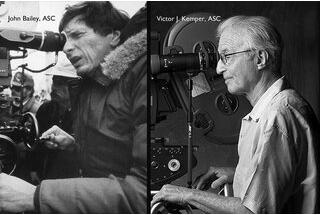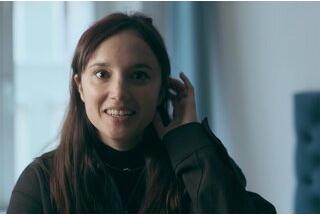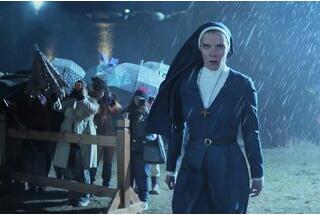Sébastien Buchmann, AFC, discusses the challenges he faced in shooting "Le Parfum vert", by Nicolas Pariser
An actor from the Comédie-Française is killed by poison in front of a dumbfounded audience. Martin, one of the actors in the company, who directly witnessed the murder, is suspected by the police and pursued by the mysterious organization that commandeered the murder. Claire, a cartoonist, will help Martin unravel the mystery of this violent death during a very eventful journey throughout Europe.
The visual choices for the general tone of the film
Sébastien Buchmann: Le Parfum vert lies on the edge between a parody of a spy film and a comedy. Vincent Lacoste is an antihero who allows himself to be guided by a woman, Sandrine Kiberlain, who wants to experience crazy adventures. To navigate between these genres, it was necessary, in my opinion, to offer a contrasted but also colorful and saturated image. A more fanciful image, which is a little more showy (unlike that of Alice et le maire)… and therefore why not with a little green, in a nod to the title. We have, as on Nicolas’ previous film, chosen to shoot in 35mm. Nicolas Pariser is very keen on it, and it was not even a subject of discussion in preparation. 35mm allows you to go straight to the point and to assert a visible image style on the dailies. It’s a form of constraint that I enjoy and, since I was practically unable to do any tests for this film, it was reassuring to shoot on film, for this very reason.
An important location is the train
SB: We faced difficulties in preparation. It’s very complicated to shoot on a train in France! It was impossible to have a Thalys to film this trip to Brussels, we were prepared to shoot in a TGV but there weren’t any free ones, unless you were shooting in the station in a TGV connected to the catenaries, meaning it would be impossible to light from the outside and would force us into a reduced filming time. So, we shot in a regional train, on a dedicated SNCF location which allowed us to operate in studio conditions… but in open air. We only got three days of shooting. Since a train car is 26 meters long, it was necessary to build a 30 meter long x 8 meter wide waterproof structure the train could be placed inside. This structure allowed me to install SkyPanels above the windows, to make light enter the train car, and Lux LEDs, to give a slightly more marked direction on one side of the train. The SkyPanels on the console created the variations of light to give the illusion of the train moving.
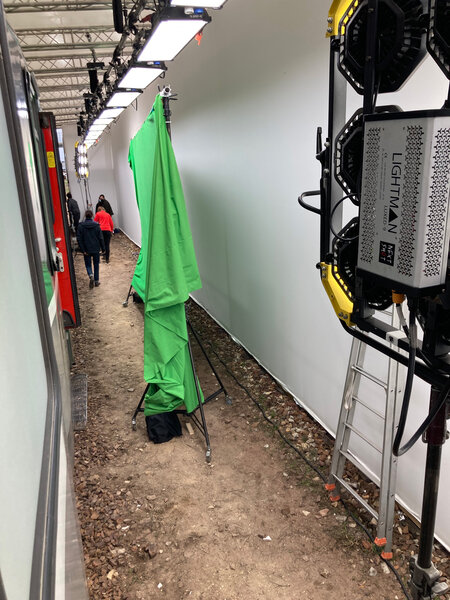
And the illusion of the landscape through the windows?
SB: The scenes to be shot involved dialogue between the two seated actors but also involved a lot of wandering throughout the train and some shots in the bar car. The VFX storyboard showed us there were too many special-effects scenes. So, I proposed we shoot the movements in long focal length to avoid having the windows in the frame as much as possible. We have added reflections from the outside on parts of the compartment. Hugues Namur, from Mikros, was in attendance during the entire shoot in the train, and he had suggested white backgrounds to avoid feedback from the green in the carriage for the shots where the windows were visible from afar. Only the shots where the actors’ hair had to be cropped were on a green screen.
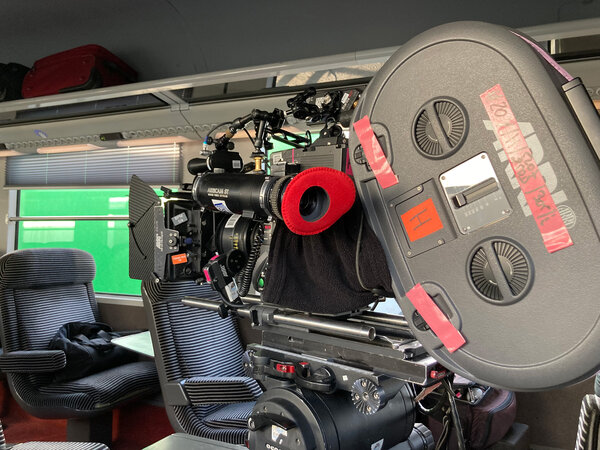
Let’s continue to Hungary, by sleeper train
SB : First of all, we had to scout the day train while we were shooting at night… And we weren’t able to turn on the lights in the train car to get a tiny idea of what they might look like on screen. But it was still less trouble than in France because Hungary has a beautiful railroad museum where we were able to shoot in a trainshed. Nicolas wanted the exterior to be completely dark to emphasize Vincent’s anxiety, so only his reflection would show in the window. So, I abandoned the idea of lighting from the outside. Everything had to come from within and it was no small feat given the narrowness of the location. We added prop lighting, designed by the set designer, Florian Sanson, and the gaffer, Vincent Piette.
The film begins at the Comédie-Française and ends in Budapest, at the Magyar Theater
SB: The post-Covid period had the effect of making it difficult to access theaters, which were running overtime when we were shooting. The Comédie-Française – except the hall – was filmed in other locations: the stage of the Opéra Comique, the dressing rooms in another theatre. Since preparation times were very short and safety standards prohibited us from leaving equipment on tripods or hanging, I used the lighting available on location. There are a lot of automatic spotlights in the Opéra Comique, I could use them to bounce the light off of canvases or the ceiling.
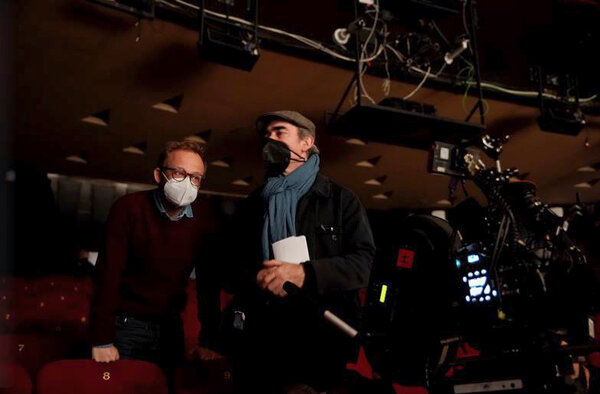
In Hungary, we spent three weeks in the Magyar Theatre, juggling with the theater’s own performance calendar. It was a very fragmented shoot and I admire the work of the script supervisor! Unfortunately, there were very few automatic lamps, especially tungsten ones, and we had to go up on the catwalk to direct them by hand. The audience is primarily illuminated by reflected light from the stage. The lighting on set was built together with the set designer, Florian Sanson, who created a set with translucid backgrounds that were lit from behind with SkyPanels.
Hitchcockian references
SB: The screenplay was riddled with direct references to North by Northwest, and some remain in the film, such as the name of the villain, Van Damme, which is the same as the character played by James Mason. And beyond that, Nicolas regularly referenced the film for the shooting breakdown or to immerse us in this curious mixture of comedy and spy film. For the revelation sequence that happens during the performance, we were instead inspired by the final scene of The Man Who Knew Too Much. The scene takes place during a concert at the Royal Albert Hall and lasts quite a long time. There are a lot of shots, on the concert, close-ups on the scores… For our scene, we had to show several characters in different places during the crucial scene that reveals the identity of the undercover spy in the company. In both cases, the spectator and the characters know that something is going to happen and are waiting for it. We didn’t cut as much as Hitchcock did, but that isn’t to the detriment of our film.
Film doesn’t put us in the same mindset as digital...
SB: I like that film imposes something; you are immediately in an interpretation of reality. On set, you have to imagine the film, you can’t see it on screen, as in digital. In digital, the film is truly constructed on the screen, which is already almost the film all by itself! It is a privilege for an operator to still be able to “imagine” the film being made and this always causes a little more stress. For example, the last sequence of Le Parfum vert takes place on a bridge in Hungary. When we got to the bridge, there was an incredible mist, we couldn’t see anything. It was our last day there, we had to shoot. I thought: if we had wanted to have a mist like this, we wouldn’t have been able to recreate it, so what can I do with it? It was strange, I acted as if we were in the studio, I lit the characters strongly, in a somewhat false way. Everyone told me we couldn’t see anything, but I knew it would be fine. On film, we don’t 100% know how it’s all going to turn out and that’s a bit magical.
(Interview by Brigitte Barbier, for the AFC, translated from French by A. Baron-Raiffe)
(The thumbnail image above shows Sandrine Kiberlain and Vincent Lacoste - © Diaphana Distribution)
 En
En
 Fr
Fr
